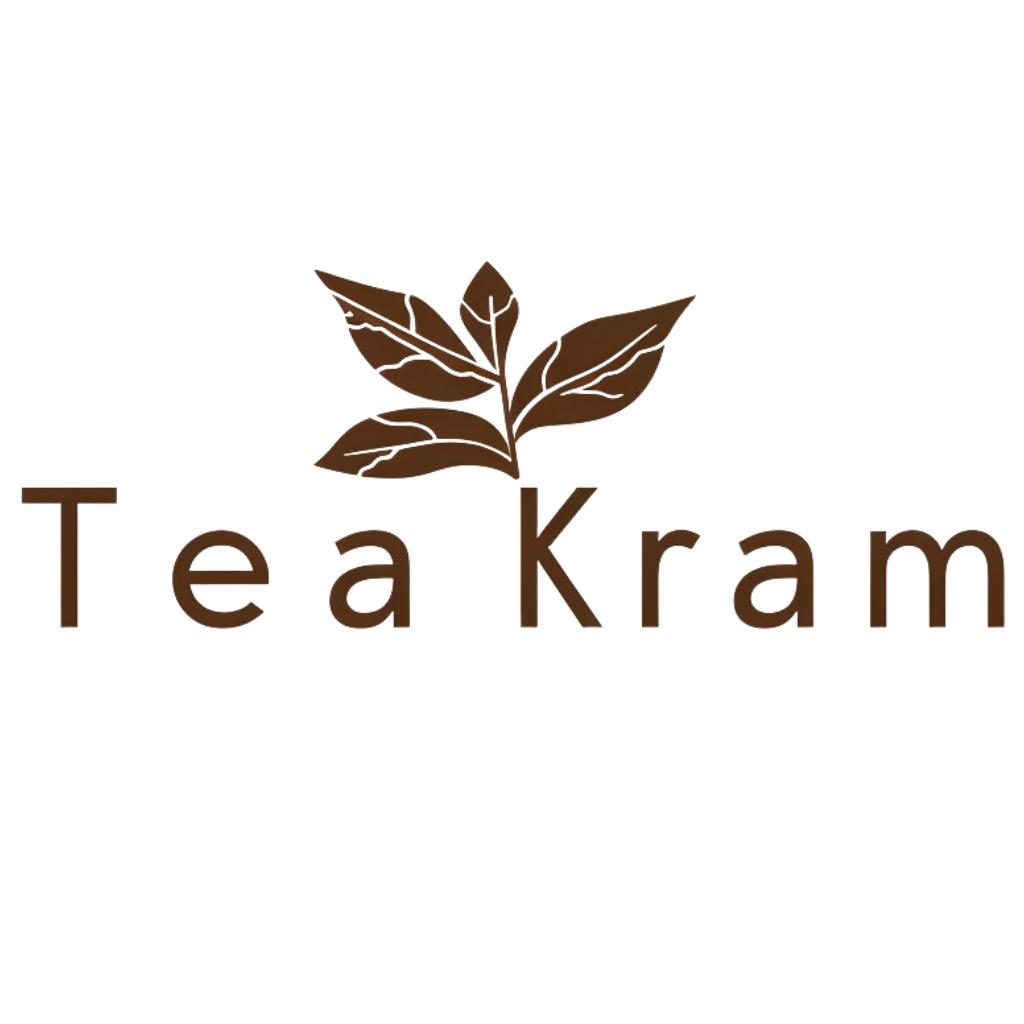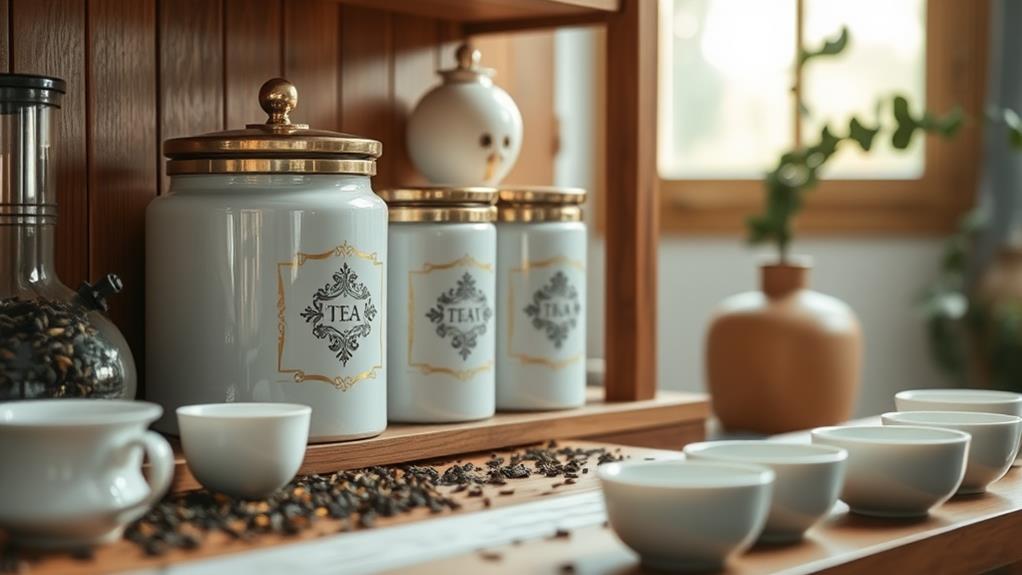Proper tea storage keeps your favorite brews fresh and flavorful. First, store tea in airtight containers to block moisture, light, and air. Metal, glass, or ceramic are great choices! Keep your stash in a cool, dark place, away from spices and humidity. Each tea type has its needs: green tea loves a sealed jar, while loose black tea thrives in cool surroundings. Look for signs of deterioration, like fading aroma or color changes—these signal it's time to reconsider your storage practices. Follow these tips, and you'll enjoy a delightful cup every time. There's so much more to discover!
Importance of Proper Tea Storage
Proper tea storage is crucial for maintaining the flavor and aroma you love. When you invest in high-quality tea, you want to savor every sip, right? The way you store your tea can significantly impact its flavor over time. Factors like light, heat, moisture, and air can degrade your tea's precious qualities, making it taste stale or bland.
Using tin storage for your loose teas can ensure maximum freshness retention and provide protection from environmental contaminants. To maximize your tea's storage duration, think about how you can shield it from these elements. Even small changes can make a big difference. For instance, keeping tea in a cool, dark place helps protect its vibrant flavors. If you can, try using airtight containers to minimize air exposure.
It's also a good idea to keep each type of tea separate. Mixing flavors can lead to unexpected and sometimes unpleasant results.
Best Containers for Tea
When it comes to storing your tea, choosing the right container is key.
You'll want something with an airtight seal to keep your tea fresh and flavorful, plus the material matters too—glass, metal, and ceramic all have their perks.
Let's chat about what works best for your favorite brews!
Airtight Seal Importance
The freshness of your tea hinges on one crucial factor: an airtight seal. When you store your tea in containers that offer airtight benefits, you're preventing moisture, air, and light from ruining that rich flavor you love.
Different seal types can make a big difference. For instance, a vacuum-sealed container eliminates air almost entirely, keeping your tea fresh for longer. On the other hand, screw-top lids can also provide a decent seal if they fit snugly. Additionally, using high-quality tea storage options helps reduce waste and supports eco-friendly practices, aligning with the benefits of reducing landfill waste.
Why does this matter? Well, tea leaves are delicate. Exposure to oxygen leads to oxidation, which can dull the flavors and aromas you cherish. If you want to enjoy the vibrant notes of your favorite blend, you'll want to prioritize airtight storage.
Think about it: how often do you find yourself reaching for a cup of tea, only to be met with a stale taste? By investing in quality containers with effective seals, you're not just preserving your tea; you're enhancing your entire tea-drinking experience.
Material Considerations
Choosing the right materials for your tea storage can significantly impact its longevity and flavor. When it comes to containers, you've got options, and each one brings its own benefits. Let's dive into ceramic vs. metal and glass vs. plastic.
Ceramic containers are fantastic for keeping tea fresh, as they're non-reactive and can maintain a stable temperature, providing exceptional heat retention that benefits the tea experience. Additionally, ceramic is generally more affordable than high-quality glass options, making it an accessible choice for tea lovers. They often come in stylish designs, making them a great addition to your kitchen.
On the other hand, metal containers, like those made from stainless steel, offer durability and an excellent airtight seal. Just make sure they're lined to prevent any metallic taste from leaching into your tea.
Now, let's discuss glass versus plastic. Glass containers are a top choice for visibility and purity since they won't absorb flavors or scents. However, be cautious—they can break easily.
Plastic containers are lightweight and less fragile, but you'll want to ensure they're BPA-free to avoid any concerns about chemicals.
Ultimately, the best container for your tea aligns with your lifestyle and taste preferences. So, choose wisely, and your tea will thank you with every delicious cup!
Ideal Temperature for Tea
What's the perfect temperature for brewing your favorite tea? Finding that sweet spot can totally elevate your tea experience. Different types of tea require different brewing temperatures to achieve optimal flavor extraction.
For instance, black tea thrives at around 200°F (93°C), while green tea prefers a cooler 175°F (80°C). Understanding the key brewing techniques is essential to mastering your tea experience.
Using the right brewing temperature is crucial; it ensures you unlock the unique flavors and aromas that each tea variety offers. If you brew at too high a temperature, you might end up with a bitter taste, while too low could lead to a flat and uninspiring cup.
Experimenting with brewing temperatures can be a fun journey! You'll discover that a slight adjustment can dramatically change the flavor profile.
Consider investing in a thermometer or an electric kettle with temperature settings. This will give you the precision you need to make that perfect cup every time.
Managing Humidity Levels
Brewing tea at the right temperature is just one part of the equation; managing humidity levels is equally important for preserving your tea's quality. High humidity can lead to moisture absorption, which affects the flavor and aroma of your tea.
To keep your favorite brews fresh, you'll need effective humidity control strategies. Here are some tips to help you out:
- Use Airtight Containers: Invest in high-quality, airtight containers to keep moisture out.
- Store in a Cool, Dry Place: Choose storage spots away from steam and humidity, like pantries or cabinets.
- Consider Silica Gel Packs: These can absorb excess moisture, ensuring your tea stays dry and flavorful.
- Monitor Humidity Levels: Use a hygrometer to keep track of the humidity in your storage area.
Preventing Light Exposure
Properly storing tea involves more than just humidity control; preventing light exposure is crucial too. When tea leaves are exposed to light, they can lose their flavor and aroma, making your delightful brew less enjoyable. To combat this, consider using innovative light filtration methods. These methods include opaque containers that block out harmful light rays, ensuring that the delicate compounds in tea remain intact.
Additionally, understanding the impact of water quality and temperature can further enhance your tea experience once it's brewed, as high water quality is essential for optimal tea brewing.
One popular solution is to invest in high-quality tea tin options. These tins not only look stylish on your shelf but are designed to keep light at bay. Choose tins made from materials that reflect light, like stainless steel or dark-painted aluminum. Some even come with a protective lining to further safeguard your precious leaves.
If you're feeling crafty, you can also repurpose dark glass jars or ceramic containers. Just make sure they're not clear! Layering your tea tins within a cupboard can also add an extra shield against light.
Avoiding Strong Odors
When it comes to keeping your tea fresh, avoiding strong odors is key.
You'll want to store your tea in sealable containers that keep out unwanted scents, so those delicate flavors shine through.
Also, steer clear of placing your tea near spices, as their strong aromas can easily seep into your tea leaves.
Sealable Containers Recommended
Many tea enthusiasts overlook the importance of using sealable containers to protect their prized leaves from strong odors.
If you want to keep your tea fresh and flavorful, consider investing in innovative storage solutions. Vacuum sealing is one of the best methods, as it removes air and locks in that delightful aroma and taste.
When choosing your containers, keep in mind various container shapes that fit your storage needs.
Here are some recommended options:
- Airtight jars: Perfect for keeping moisture and odors at bay.
- Vacuum-sealed bags: Space-saving and excellent for long-term storage.
- Metal tins: Stylish and effective at blocking out light and odors.
- Glass containers: Aesthetic and non-reactive, ensuring your tea's integrity.
Keep Away From Spices
Keeping your tea away from spices is crucial for preserving its delicate flavors. When tea and spices share a space, you risk spice contamination, which can drastically alter your tea experience. Strong odors from spices can seep into your tea, leading to unwanted flavor transfer.
This is particularly important to consider when pairing tea with food, as the purity of your tea enhances the overall dining experience. Imagine sipping a light floral green tea only to find it carrying the taste of garlic or cumin—definitely not what you'd in mind!
To keep your tea pure, store it in a dedicated area, away from spice cabinets and cooking zones. Opt for airtight containers that block out odors and light, ensuring your tea stays fresh and flavorful.
If you've got a spice rack nearby, consider storing your tea in a different room or a high cupboard.
Long-Term vs. Short-Term Storage
Understanding the differences between long-term and short-term tea storage can significantly impact the quality of your brews.
When you know how to store your tea properly, you can enjoy both short-term benefits and long-term strategies for freshness.
For short-term storage, think about:
- Keeping tea in a cool, dark place to preserve flavor.
- Using airtight containers to prevent moisture and odors.
- Enjoying your tea within a few months for optimal taste.
- Rotating your tea stock to always have fresh options.
On the other hand, long-term storage requires a bit more planning.
You'll want to consider factors like humidity and temperature.
Ideally, you should store your tea in a vacuum-sealed container or a dark, airtight jar. This helps maintain its unique flavors and aromas over time.
How to Store Different Types of Tea
When it comes to storing different types of tea, each variety has its own unique needs to maintain freshness and flavor.
For green tea, keep it in an airtight container away from light and heat; this helps preserve its delicate taste and supports its unique health properties.
Herbal tea, with its vibrant flavors, also benefits from airtight storage, but you can experiment with clear glass jars to show off those colorful leaves!
Black tea and oolong tea thrive in a cool, dark place, and they love being stored in loose leaf form.
Keep those tea bags sealed tightly to avoid moisture.
When it comes to white tea, less is more; store it in a breathable container to let it age gracefully over time.
Flavored tea can be a bit tricky, as it tends to absorb other aromas.
So, stash it in a separate container, ensuring it's tightly sealed.
Lastly, if you're dealing with pu erh tea, embrace its aging potential by keeping it in a dry, ventilated space.
Remember, the right storage can elevate your tea experience, so take the time to care for each type!
Happy brewing!
Signs of Tea Deterioration
When your tea starts showing signs of deterioration, it's time to take note.
You might notice a loss of aroma or even a change in color, which can signal that your tea isn't as fresh as it once was.
Keeping an eye on these indicators helps ensure you enjoy the best flavor in every cup!
Aroma Loss Indicators
You've probably noticed that tea can lose its delightful aroma over time, and recognizing the signs of this deterioration is crucial for maintaining your brew's quality.
When it comes to aroma preservation, you want to be alert to several indicators that your tea might be losing its charm.
Here are some key signs to watch out for:
- Faded scent: If your tea no longer has that enticing fragrance, it's a red flag.
- Weird odors: Any off-putting smells can indicate that the tea's freshness is compromised.
- Flat taste: When the flavor seems muted or dull, it's often due to aroma loss.
- Packaging damage: If the bag or container shows signs of wear, your tea is likely exposed to air, affecting scent enhancement.
To maintain your tea's aroma, invest in proper storage solutions. Airtight containers and cool, dark places can work wonders.
Color Change Signs
Over time, tea can undergo noticeable color changes that signal its deterioration. You might find that the vibrant color intensity of your favorite leaves starts to fade, indicating that freshness is slipping away.
Keep an eye on those hue variations; if your green tea turns a dull brown or your black tea loses its rich, deep color, it's time to reassess its quality.
These color shifts don't just happen overnight. They're usually a result of exposure to air, light, and moisture, which can degrade the tea's natural compounds. If you notice that your tea's color has dulled or changed dramatically, it may have reached the end of its prime.
But don't worry! You can still enjoy tea for its delightful flavors and aromas. Just be proactive about storage. Use opaque, airtight containers and keep them in a cool, dark place.
This way, you'll help preserve that beautiful color intensity and prevent any unwanted hue variations. So, when you brew your next cup, take a moment to appreciate the vibrant colors, remembering that they reflect the tea's quality and freshness.
Cheers to your tea journey!
Tips for Reviving Stale Tea
If you've ever opened a tin of tea only to be greeted by a lackluster aroma, you know how disappointing stale tea can be.
Fortunately, there are some innovative ways to revive it and bring back its vibrant flavor. Here are a few tips for flavor enhancement:
- Re-steep: Sometimes, simply brewing your stale tea again can help release hidden flavors, especially if it's a robust black or oolong.
- Add Fresh Ingredients: Consider mixing in fresh herbs, citrus peels, or spices. This not only masks the staleness but also creates a unique blend.
- Cold Brew: If your tea's lost its punch, try cold brewing it. This method often yields a smoother, more delicate flavor profile, perfect for refreshing iced tea.
- Combine with Fresh Tea: Mix stale tea with a fresh batch of the same type. This can balance out the flavor, giving you a second chance at enjoyment.
FAQ
Can I Store Tea in the Refrigerator or Freezer?
You can store tea in the refrigerator for its benefits, like maintaining freshness, but avoid the freezer due to drawbacks like moisture and flavor loss. Experiment with methods to find what preserves your tea best!
How Often Should I Check My Tea for Freshness?
You should check your tea's freshness like a hawk! Aim for optimal checking every few weeks, observing tea freshness indicators like aroma and color. This'll ensure your brews remain vibrant and innovative, delighting your senses!
Is It Safe to Mix Different Types of Tea in One Container?
Mixing different types of tea in one container can be creative, but it might alter flavor profiles. If you're experimenting with tea blending, ensure the flavors complement each other for an innovative tasting experience.
What Is the Shelf Life of Different Tea Varieties?
Different tea varieties have varying shelf lives, typically ranging from six months to several years. To ensure optimal tea aging and flavor preservation, store them properly, avoiding light, moisture, and strong odors. Enjoy your innovative brews!
Are There Any Specific Storage Tips for Herbal Teas?
Storing herbal tea's like preserving a delicate painting. Use airtight storage containers for flavor preservation, and keep them in a cool, dark place to control moisture. Your tea will thank you with every flavorful sip!
Final Thoughts
Now that you know how to store your tea properly, why wouldn't you want to keep it fresh and flavorful? By using the right containers, managing temperature and humidity, and shielding your tea from light, you can enjoy each cup just as it was meant to be. Whether you're sipping green tea or a robust black, good storage makes all the difference. So, go ahead and treat your tea with the care it deserves—your taste buds will thank you!




Pingback: Welcome Summer With Cold Brew - TeaKram
Pingback: Chinese Silver Needles Tea - TeaKram